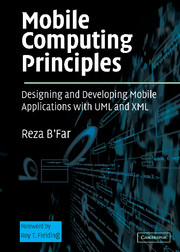Book contents
- Frontmatter
- Contents
- Foreword by Roy T. Fielding
- Acknowledgments
- SECTION 1 INTRODUCTIONS TO THE MAIN TOPICS
- SECTION 2 DEVICE-INDEPENDENT AND MULTICHANNEL USER INTERFACE DEVELOPMENT USING UML
- Chapter 5 Generic User Interface Development
- Chapter 6 Developing Mobile GUIs
- Chapter 7 VUIs and Mobile Applications
- Chapter 8 Multichannel and Multimodal User Interfaces
- SECTION 3 ADDITIONAL DIMENSIONS OF MOBILE APPLICATION DEVELOPMENT
- SECTION 4 PUTTING THE PROJECT TOGETHER
- References
- Index
Chapter 7 - VUIs and Mobile Applications
from SECTION 2 - DEVICE-INDEPENDENT AND MULTICHANNEL USER INTERFACE DEVELOPMENT USING UML
Published online by Cambridge University Press: 03 September 2009
- Frontmatter
- Contents
- Foreword by Roy T. Fielding
- Acknowledgments
- SECTION 1 INTRODUCTIONS TO THE MAIN TOPICS
- SECTION 2 DEVICE-INDEPENDENT AND MULTICHANNEL USER INTERFACE DEVELOPMENT USING UML
- Chapter 5 Generic User Interface Development
- Chapter 6 Developing Mobile GUIs
- Chapter 7 VUIs and Mobile Applications
- Chapter 8 Multichannel and Multimodal User Interfaces
- SECTION 3 ADDITIONAL DIMENSIONS OF MOBILE APPLICATION DEVELOPMENT
- SECTION 4 PUTTING THE PROJECT TOGETHER
- References
- Index
Summary
It is forbidden to kill; therefore all murderers are punished unless they kill in large numbers and to the sound of trumpets.
VoltaireINTRODUCTION
As their name indicates, voice user interfaces (VUIs) are interfaces that allow users to interact with computing systems through use of voice. Although our voice can be used in different ways, VUIs typically refer to communication through the use of language. This narrows down the problem at hand as communication through VUIs is a subset of communicating through aural user interfaces. It is possible to communicate with computers through sounds other than pronounced words and sentences. Different sounds can be used to communicate information through their frequency, amplitude, duration, and other properties that make them unique. However, language is how we naturally communicate, be it through voice or text; therefore, when referring to VUIs, we refer to communicating with machines through using pronounced language.
It is also true that most us have had very frustrating experiences trying to bypass the voice recognition system and reach an operator. However, this is not an indicator of the lack of value of voice recognition systems. In fact, most systems that lead users to be frustrated are those that have not been well designed or those that require a high degree of cognition by the computing system: something that computing systems do not do well yet. As we have already seen, the user interface problem is one of the biggest problems in mobile computing.
- Type
- Chapter
- Information
- Mobile Computing PrinciplesDesigning and Developing Mobile Applications with UML and XML, pp. 399 - 496Publisher: Cambridge University PressPrint publication year: 2004



